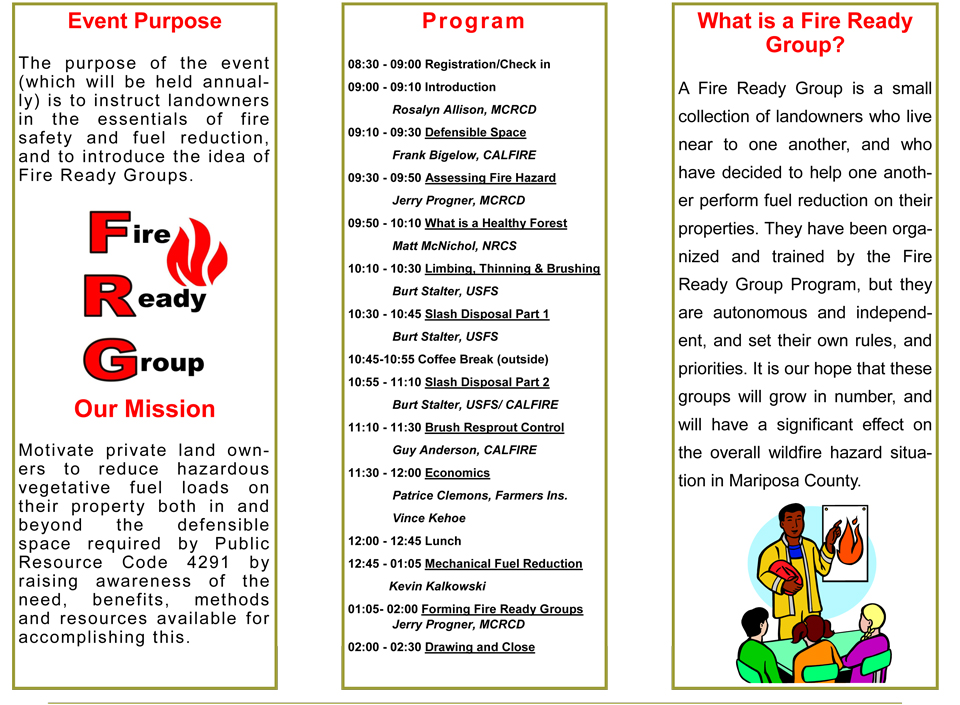Private landowners in the Sierra Foothills are responsible for making their land fire-safe, and in general they are not meeting their responsibility. While they may have cleared around their homes and outbuildings for the state-mandated 100 foot radius, they have tended to ignore the brush and other flammable materials on the rest of their property. In the event of a wildland fire, many of the plants and trees on their property could burn, leaving a stark, desolate viewscape. These landowners present a danger to themselves, their neighbors, and the county tax base. The desolation from a wildfire can last for decades.
A fire-safe landscape is one which allows a wildfire to pass through with a flame height no greater than 12-18 inches without killing many trees. This implies that brush has been cut and then chipped, piled and burned, or cut up in small pieces and left to decompose. It means trees have been thinned out and ‘limbed up’ to a height of 10 feet and the slash disposed of using one of the methods above. The most straightforward way to accomplish the cutting, thinning, and limbing is by hand with a chainsaw, which is labor-intensive and potentially expensive if a hired person or crew is used. Cost per acre using a hired hand crew ranges from $1500 to $3000 depending on the terrain and fuel load.
Landowners may also contract for the use of a mechanical device called a masticator. Masticators vary in design. Some resemble a huge lawnmower – one that can take down brush and 12” trees with ease. Others resemble a back-hoe with a rotating cutter head on the boom end. The finished product from a mastication job can vary between fine mulch and shards of wood a foot or more long. The fineness depends on the kind of device used, the skill of the operator, the desires of the landowner, the terrain, and how much the landowner is willing to pay. A ‘fine’ result may require two or more passes with the masticator, which means more time, and higher cost. Cost per acre using a masticator ranges from $500-1500. Small jobs may be charged by the hour and will be more expensive per acre. The two most important variables affecting cost are terrain and fuel load. You may find that your land is unsuitable for mastication because of rocks or steepness. Allowable steepness depends on the design of the masticator and rockiness of the land. More than 30 degrees of slope may be a problem. And mastication devices hate rocks.
Often, a hand crew is employed to work with the masticator. The crew can go in first, limb up and thin the trees and drag the slash into the open. The masticator can then chew up the slash along with the rest of the brushy material not already cut. Alternatively, the masticator can go in first to dispose of the brush and excess trees, and the hand crew can follow to do the limbing and finish the thinning. The slash can then be piled and burned or cut up into small pieces and left to decompose. Hand crews doing this kind of work generally charge $200-300 per acre.
The land must be maintained after initial treatment has been accomplished. If the cleared land is left alone for 8-10 years, it will have returned to its former state. In order to avoid this, new sprouting brush must be removed or killed. The most efficient way to do this is to use an herbicidal spray. Glyphospate (the active ingredient in Round-Up) or Triclopyr (the active ingredient in Brush-B-Gone) are the most common products in use. The herbicide is spot-sprayed on the sprouting brush, where it is absorbed by the leaves on the plant. Its effect on the environment is well-understood and thought to be nil, since it becomes inert when it contacts the soil or breaks down in sunlight. To be absolutely safe, care must be taken to keep its use at least 40 feet from streams and gulches, and skin contact should be avoided. Herbicide treatment should take place 8-18 months after initial clearing, and potentially again 2-3 years after that. Some landowners may wish to avoid the use of herbicide, fearing environmental damage. Each landowner must balance that risk (which is small) against the risk of destructive wildfire to the environment, and against the increased cost of re-doing the fuel reduction every 10 years. Landowners may apply the herbicide themselves using over-the-counter products like RoundUp and a back-pack sprayer. If increased effectiveness is desired, a licensed pest control contractor may be hired to apply a stronger version of the herbicide at a cost of $150-200 per acre.
Part One: Fire Ready Group in Mariposa County: Fire History in the Sierra Foothills
Part Two: Fire Ready Group in Mariposa County: Fire Safety and Volunteerism in the Mid-20th Century
Part Three: Fire Ready Group in Mariposa County: The Telegraph Fire Remembered
Below is a flyer for the First Annual Fire Ready Workshop to be held in Midpines on October 11, 2014.












